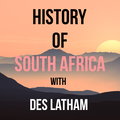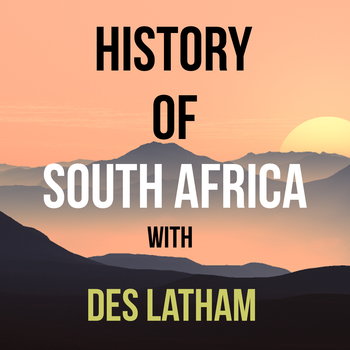
Episode 145 - The seminal Battle on the Ncome known as Blood River
Loading player...
This is episode 145 - we’re joining the AmaZulu and the Voortrekkers at the apocalyptic clash on the River Ncome, which was soon renamed Blood River.
This battle has seared its way into South African consciousness — it is so symbolic that its reference frames modern politics. Just when someone comes along and pooh poohs Blood River’s importance, events conspire against them.
And so, to the matter at hand.
We join the two forces preparing for battle on the evening of 15th December 1838, the amaButho arraigned in their units below the Mkhonjane Mountain east of the Ncome, and the 464 Voortrekker men waiting inside their 64 wagons.
Joining them was Alexander Biggar the Port Natal trader and 60 black levies, Biggar wanted revenge for the death of his son Robert killed by the AmaZulu at the Battle of Thukela.
Also at hand were Robert Joyce and Edward Parker, aiding Voortrekker commander Andries Pretorius as intelligence officers. Both were fluent in Zulu and had already passed on vital information to Pretorius about Prince Mpande who had to flee into exile. Dingane had tried to have his half-brother assassinated - the paranoid Zulu king thought Mpande was planning to oust him as he had done to his half-brother, Shaka.
The scene was set folks for this seminal battle at a picturesque place.
The laager had been drawn up in an oval shape on the western bank of the Ncome river, to its south was a deep donga about fifty meters away that had been scoured by rain, and this ran into the Ncome with banks that were over two meters high. While AmaZulu warriors could hide in this donga, it really worked in the trekkers favour because it broke up the ground - they could not charge the wagons but had to clamber over the trenchlike ledge and were then easy pickings for the Boer sharpshooters.
The Eastern side of the laager faced the Ncome River - about 80 meters away and this was regarded as even more difficult to assault. The River bank was muddy, and covered in reeds, making the approach almost impossible to achieve with any speed. Almost half a kilometer upstream, this river broadened into a marsh dotted with deep pools and crossing at that point would be almost impossible.
Downstream from the laager was a very deep hippo pool or seekoeigat as it was known, so deep that the Boers couldn’t feel its bottom with their long whipstocks. No AmaZulu warrior would be crossing there either.
More than half a kilometer downstream was a well used drift, and south east of the Ncome was a broad open plain dotted with small marshes and pools, and further south east lies the Shogane ridge, more than a kilometer away.
It was summer, and the rains had come. The river was flooding which was to further complicate the AmaZulu assault.
On the other side of the River, near Mthonjane mountain, Zulu commander Ndlela kaSompisi and his two IC Nzobo were finalising their plans on the night of 15th December 1838.
IT was well before dawn on the 16th December that Ndlela ordered his warriors to rise and prepare.
This battle has seared its way into South African consciousness — it is so symbolic that its reference frames modern politics. Just when someone comes along and pooh poohs Blood River’s importance, events conspire against them.
And so, to the matter at hand.
We join the two forces preparing for battle on the evening of 15th December 1838, the amaButho arraigned in their units below the Mkhonjane Mountain east of the Ncome, and the 464 Voortrekker men waiting inside their 64 wagons.
Joining them was Alexander Biggar the Port Natal trader and 60 black levies, Biggar wanted revenge for the death of his son Robert killed by the AmaZulu at the Battle of Thukela.
Also at hand were Robert Joyce and Edward Parker, aiding Voortrekker commander Andries Pretorius as intelligence officers. Both were fluent in Zulu and had already passed on vital information to Pretorius about Prince Mpande who had to flee into exile. Dingane had tried to have his half-brother assassinated - the paranoid Zulu king thought Mpande was planning to oust him as he had done to his half-brother, Shaka.
The scene was set folks for this seminal battle at a picturesque place.
The laager had been drawn up in an oval shape on the western bank of the Ncome river, to its south was a deep donga about fifty meters away that had been scoured by rain, and this ran into the Ncome with banks that were over two meters high. While AmaZulu warriors could hide in this donga, it really worked in the trekkers favour because it broke up the ground - they could not charge the wagons but had to clamber over the trenchlike ledge and were then easy pickings for the Boer sharpshooters.
The Eastern side of the laager faced the Ncome River - about 80 meters away and this was regarded as even more difficult to assault. The River bank was muddy, and covered in reeds, making the approach almost impossible to achieve with any speed. Almost half a kilometer upstream, this river broadened into a marsh dotted with deep pools and crossing at that point would be almost impossible.
Downstream from the laager was a very deep hippo pool or seekoeigat as it was known, so deep that the Boers couldn’t feel its bottom with their long whipstocks. No AmaZulu warrior would be crossing there either.
More than half a kilometer downstream was a well used drift, and south east of the Ncome was a broad open plain dotted with small marshes and pools, and further south east lies the Shogane ridge, more than a kilometer away.
It was summer, and the rains had come. The river was flooding which was to further complicate the AmaZulu assault.
On the other side of the River, near Mthonjane mountain, Zulu commander Ndlela kaSompisi and his two IC Nzobo were finalising their plans on the night of 15th December 1838.
IT was well before dawn on the 16th December that Ndlela ordered his warriors to rise and prepare.

